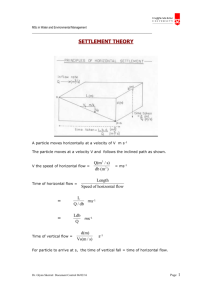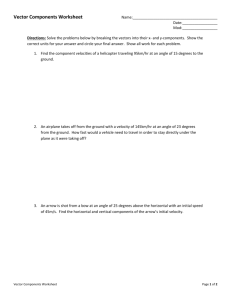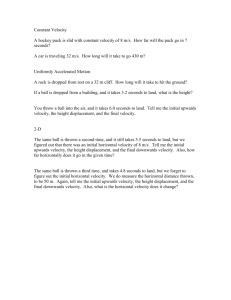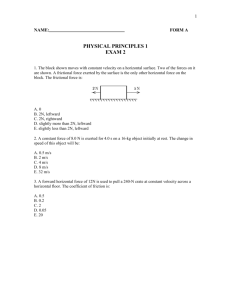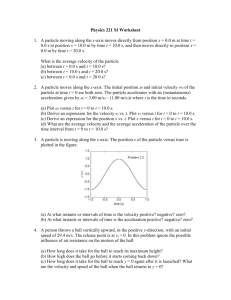PHYSICS DPP-4 – Click Here To
advertisement
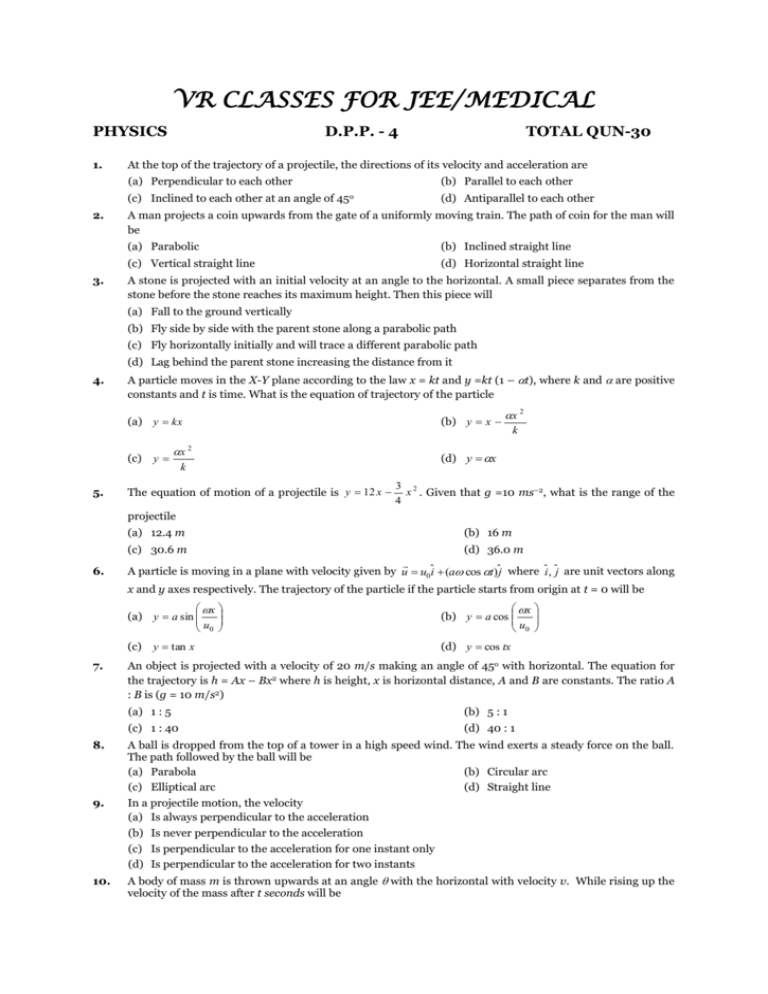
VR CLASSES FOR JEE/MEDICAL PHYSICS 1. 2. 3. D.P.P. - 4 TOTAL QUN-30 At the top of the trajectory of a projectile, the directions of its velocity and acceleration are (a) Perpendicular to each other (b) Parallel to each other (c) Inclined to each other at an angle of 45o (d) Antiparallel to each other A man projects a coin upwards from the gate of a uniformly moving train. The path of coin for the man will be (a) Parabolic (b) Inclined straight line (c) Vertical straight line (d) Horizontal straight line A stone is projected with an initial velocity at an angle to the horizontal. A small piece separates from the stone before the stone reaches its maximum height. Then this piece will (a) Fall to the ground vertically (b) Fly side by side with the parent stone along a parabolic path (c) Fly horizontally initially and will trace a different parabolic path (d) Lag behind the parent stone increasing the distance from it 4. A particle moves in the X-Y plane according to the law x = kt and y =kt (1 – t), where k and are positive constants and t is time. What is the equation of trajectory of the particle (a) y kx (c) 5. y x 2 k The equation of motion of a projectile is y 12 x (b) y x x 2 k (d) y x 3 2 x . Given that g =10 ms–2, what is the range of the 4 projectile (a) 12.4 m (b) 16 m (c) 30.6 m 6. (d) 36.0 m A particle is moving in a plane with velocity given by u u0ˆi (a cos t)ˆj where ˆi , ˆj are unit vectors along x and y axes respectively. The trajectory of the particle if the particle starts from origin at t = 0 will be x (a) y a sin u0 (c) 7. 8. y tan x x (b) y a cos u0 (d) y cos tx An object is projected with a velocity of 20 m/s making an angle of 45o with horizontal. The equation for the trajectory is h = Ax – Bx2 where h is height, x is horizontal distance, A and B are constants. The ratio A : B is (g = 10 m/s2) (a) 1 : 5 (b) 5 : 1 (c) 1 : 40 (d) 40 : 1 9. A ball is dropped from the top of a tower in a high speed wind. The wind exerts a steady force on the ball. The path followed by the ball will be (a) Parabola (b) Circular arc (c) Elliptical arc (d) Straight line In a projectile motion, the velocity (a) Is always perpendicular to the acceleration (b) Is never perpendicular to the acceleration (c) Is perpendicular to the acceleration for one instant only (d) Is perpendicular to the acceleration for two instants 10. A body of mass m is thrown upwards at an angle with the horizontal with velocity v. While rising up the velocity of the mass after t seconds will be 11. (a) (v cos )2 (v sin )2 (c) v 2 g 2 t 2 (2 v sin ) gt (b) (d) v 2 g 2 t 2 (2 v cos ) gt A boy throws a ball with a velocity V0 at an angle to the horizontal. At the same instant he starts running with uniform velocity to catch the ball before it hits the ground. To achieve this, he should run with a velocity of (a) V0 cos (b) V0 sin (c) V0 tan 12. 13. 15. 16. (d) V02 tan From the top of a tower 19.6 m high, a ball is thrown horizontally. If the line joining the point of projection to the point where it hits the ground makes an angle of 45o with the horizontal, then the initial velocity of the ball is (a) 9.8 ms–1 (b) 4.9 ms–1 (c) 14.7 ms–1 (d) 2.8 ms–1 When a particle is thrown horizontally, the resultant velocity of the projectile at any time t is given by 1 2 gt (a) gt (b) 2 (c) 14. (v cos v sin )2 gt u2 g2t2 (d) u2 g2t2 A body is thrown horizontally from the top of a tower of height 5 m. It touches the ground at a distance of 10 m from the foot of the tower. The initial velocity of the body is (g = 10 ms–2) (a) 2.5 ms–1 (b) 5 ms–1 (c) 10 ms–1 (d) 20 ms–1 An aeroplane is moving with a horizontal velocity u at a height h above the ground. If a packet is dropped from it the speed of the packet when it reaches the ground will be (a) (u 2 2 gh)1 / 2 (b) (2 gh)1 / 2 (c) (u 2 2 gh)1 / 2 (d) 2 gh A particle is projected with a speed V from a point O making an angle of 30o with the vertical. At the same instant, a second particle is thrown vertically upwards from a point A. The two particle reach H, the V highest point on the parabolic path of particle simultaneously. Then ratio is v V (a) 3 2 H (b) 2 3 (c) 2 30o 3 (d) 17. 3 2 A (d) 700 m/sec A particle is thrown upward with a speed u at an angle with the horizontal. When the particle makes an angle with the horizontal, its speed changes to v, then (a) v u cos cos (b) v u cos sec (c) v u cos 19. O Two paper screens (A) and (B) are separated by a distance of 100 m. A bullet pierces (A) and (B) the hole in (B) is 10 cm below the hole is (A). If the bullet is travelling horizontally at the time of hitting (A). Then velocity of the bullet at (A) is (a) 100 m/sec (b) 200 m/sec (c) 600 m/sec 18. v 60o (d) v u sec cos Mr. Naveen kicked off a football with an initial speed 19.6 m/s at a projection angle 45o. A receiver on the goal line 67.4 m away in the direction of the kick starts running to meet the ball at that instant. What must be his speed so that he could catch the ball before hitting the ground (a) 2.82 m/s (b) 2 / 2 m / s (c) 39.2 m/s (d) 10 m/s 20. Two balls of same mass are thrown horizontally from the top of a tower in the opposite direction with velocities 3 m/s and 4 m/s. The distance between the balls, when their velocities are mutually perpendicular will be nearest to (a) 10 m (b) 7 m (c) 5 m (d) 2.5 m 21. A motorcyclist starts from the bottom of a slope of angle 45 o to cross the valley PR as shown in the figure. The width of the valley is 90 m and length of the slope is 80 required to clear the valley will be (a) 70 m/s 2 m . The minimum velocity at point O Q R P (b) 30 m/s (c) 50 m/s O 45o (d) 100 m/s 22. From the top of a tower of height h a body of a mass m is projected in the horizontal direction with a velocity v. It falls on the ground at a distance x from the tower. If a body of mass 2 m is projected from the top of another tower of height 2 h in the horizontal direction so that it falls on the ground at a distance 2x from the tower, the horizontal velocity of the second body is (a) 2 v (b) 2v (c) v 2 (d) v 2 30o 23. A cricket ball is thrown with a velocity of 15 m/s at an angle of with the horizontal. The time of flight of the ball will be (g = 10 m/s2) (a) 1.5 s (b) 2.5 s (c) 3.5 s (d) 4.5 s 24. If t1 be the time taken by a body to clear the top of a building and t2 be the time spent in air, then t2 : t1 will be (a) 1 : 2 (b) 2 : 1 (c) 1 : 1 (d) 1 : 4 25. A stone is thrown at an angle to the horizontal reaches a maximum height h. The time of flight of the stone is (a) 26. (2h sin ) /g 28. (c) 2 (2h) /g (d) (2h) /g A bomb is fired from a cannon with a velocity of 1000 m/s making an angle of 30o with the horizontal. What is the time taken by the bomb to reach the highest point (a) 11 sec 27. (b) 2 (2h sin ) /g (b) 23 sec (c) 38 sec (d) 51 sec Two bullets are fired with horizontal velocities of 50 m/s and 100 m/s from two guns at a height of 19.6 m. Which bullet will strike first (a) First (b) Second (c) Simultaneously (d) None of these A hiker stands on the edge of a cliff 490 m above the ground and throws a stone horizontally with a speed of 15 ms–1. The time taken by the stone to reach the ground is (a) 10 s (b) 5 s (c) 12 s (d) 15 s 29. Galileo’s experiment showed that if two bodies of unequal masses are dropped from the same height, the time required by them to reach the ground are equal. But if they are thrown vertically upwards with the same initial velocity, the ratio of the time required to reach the ground is equal to (a) The ratio of their masses (b) The inverse of the ratio of their masses (c) One (d) The product of their masses 30. A particle is projected with a speed 2 gh so that it clears two walls of equal height h which are at a distance 2h from each other. The time taken by the particle to pass between the two walls is (a) 2h g (b) 2h g (c) 2 h g (d) 2 h g

